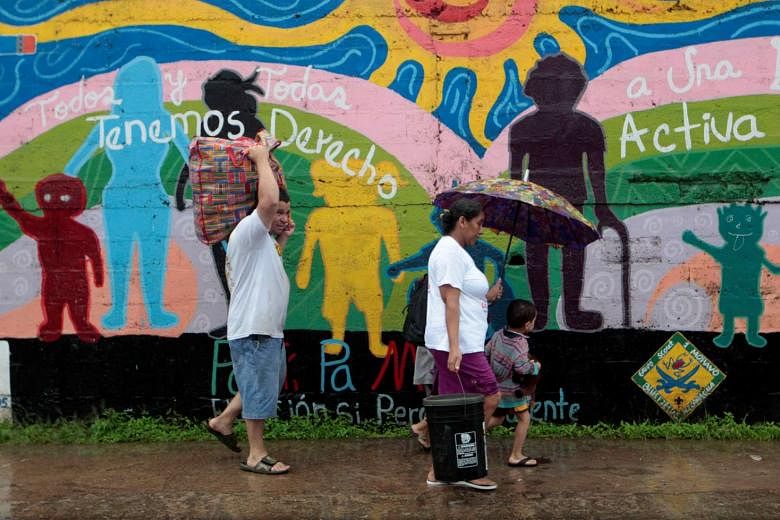BLUEFIELDS, Nicaragua (AFP) - A fierce hurricane and a powerful offshore earthquake struck Central America at the same time on Thursday (Nov 24), triggering emergency responses in Nicaragua, El Salvador and Costa Rica, and prayers among fearful populations.
Hurricane Otto - a storm packing winds of 175kmh - hit first, ploughing into Nicaragua's southern Caribbean coast.
Communities in that zone and in northern neighboring Costa Rica were evacuated ahead of it. There were no immediate reports of any deaths.
Just an hour later came the earthquake, with a magnitude of 7 and located 120km off El Salvador in the Pacific Ocean, on the other side of the Central American isthmus. It was felt also in Nicaragua's capital Managua and in Costa Rica.
While there were no immediate reports of damage or casualties from the temblor, El Salvador and Nicaragua issued a tsunami alert for their Pacific coasts, and El Salvador ordered all people in the zone to evacuate.
The double whammy was a dire test for a largely poor region generally lacking resources and preparedness for major disasters.
Faced with a hurricane and possible tsunami, Nicaraguan President Daniel Ortega on Thursday declared a national emergency - a step Costa Rica had already taken ahead of Hurricane Otto.
The storm was expected to chew its way along a broad swath of territory on both sides of the Nicaragua-Costa Rica border into Friday, losing strength as it went.
But the US National Hurricane Centre warned Otto's trailing rains "will likely result in life-threatening flash floods and mudslides."
Earlier this week, the outer bands of the storm caused the deaths of four people in Panama.
The hurricane came ashore Thursday near San Juan de Nicaragua, also known as Greytown, south of the city of Bluefields and close to the Costa Rican border.
"The wind is very strong and it's raining a lot," a local resident, Aldrick Beckford, told AFP by telephone. "We just saw neighbours' roofs collapse."
A reporter for Nicaraguan state television in San Juan de Nicaragua described a "difficult" situation with brutal gusts. "There are cables fallen, trees brought down," he told Channel 4 television.
The wind lifted off the roof of the town hall, which had been operating as an emergency coordination centre.
In Bluefields, a city of 45,000 people, and elsewhere, panic-buying cleared shops of bottled water, battery-powered lamps and plastic bags. On Wednesday, hundreds crammed onto boats to flee, while others who remained hammered metal sheeting over windows.
"This is the first time a hurricane has hit here," said Faucia Pena, an inhabitant of Bluefields. "We are asking God to end it or send it elsewhere. Everybody is afraid."
Both Nicaragua and Costa Rica closed schools, mobilised emergency crews and issued red alerts for areas across much of their territories for the hurricane.
They also carried out evacuations, though some residents in northern Costa Rica decided to stay put to guard against looters.
One woman who did evacuate her home near the village of Barra del Colorado, Teresa Romero, 52, told AFP that around 10 male locals had refused to leave. She was taking shelter in a church near the capital San Jose.
"Otto is the southernmost landfalling hurricane in Central America on record," the US hurricane centre said.
A previous, far-stronger hurricane, Matthew, devastated parts of southern Haiti early last month, killing 546 people and leaving nearly 175,000 homeless.
The strong earthquake on the other side of the region came as the hurricane was making its way west.
It occurred at a depth of 10.3km, according to the US Geological Survey - sufficiently shallow to spark fears in the Salvadoran government of a possible tsunami.
"All protection mechanisms have been activated under which we have started evacuations," the minister in charge of the emergency response, Aristides Valencia, said on state radio.
Officials were scrambling to evaluate the impact of the quake. The task was made more difficult because some telephone lines in the capital San Salvador were cut.
People ran out of dozens of buildings in the city in panic, fearing aftershocks.

